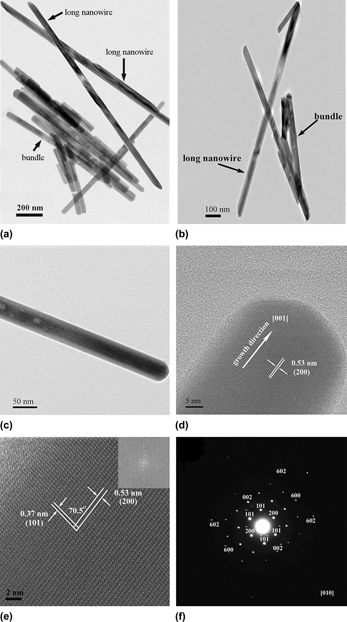Crossref Citations
This article has been cited by the following publications. This list is generated based on data provided by
Crossref.
Zhou, Xiaoping
Ma, Lin
and
Feng, Zongcai
2015.
Synthesis and Characterization of Bismuth Sulfide Nanorods by Solvothermal Route.
Chemistry Letters,
Vol. 44,
Issue. 8,
p.
1113.
Panmand, Rajendra P.
Sethi, Yogesh A.
Deokar, Rajashree S.
Late, Datta J.
Gholap, Haribhau M.
Baeg, Jin-Ook
and
Kale, Bharat B.
2016.
In situ fabrication of highly crystalline CdS decorated Bi2S3 nanowires (nano-heterostructure) for visible light photocatalyst application.
RSC Advances,
Vol. 6,
Issue. 28,
p.
23508.
Senevirathna, Dimuthu. C.
Blair, Victoria. L.
Werrett, Melissa. V.
and
Andrews, Philip C.
2016.
Taking bismuthinite to bismuth sulfide nanorods in two easy steps.
Dalton Transactions,
Vol. 45,
Issue. 12,
p.
4998.
Noordeen, Abdul Kalam
Sambasivam, Sankar
Chinnasamy, Sengottaiyan
Ramasamy, Jayavel
and
Subramani, Thiyagu
2018.
Hierarchical Flower Structured Bi2S3/Reduced Graphene Oxide Nanocomposite for High Electrochemical Performance.
Journal of Inorganic and Organometallic Polymers and Materials,
Vol. 28,
Issue. 1,
p.
73.
Jang, Min‐Kyeong
Cho, Young‐Sik
Park, Garam
Oh, In‐Hwan
and
Huh, Young‐Duk
2018.
Template‐assisted Morphological Evolution of Cu2S and Cu2MoS4 from Octahedral Cu2O Crystals.
Bulletin of the Korean Chemical Society,
Vol. 39,
Issue. 11,
p.
1302.
Miniach, Ewa
and
Gryglewicz, Grażyna
2018.
Solvent-controlled morphology of bismuth sulfide for supercapacitor applications.
Journal of Materials Science,
Vol. 53,
Issue. 24,
p.
16511.
Salvatore, Kenna L.
Tan, Sha
Tang, Christopher
Gan, Joceline
Licht, Matthew
Lin, Cheng-Hung
Tong, Xiao
Chen-Wiegart, Yu-chen Karen
Takeuchi, Esther S.
Takeuchi, Kenneth J.
Marschilok, Amy C.
and
Wong, Stanislaus S.
2020.
Microwave-Based Synthesis of Functional Morphological Variants and Carbon Nanotube-Based Composites of VS4 for Electrochemical Applications.
ACS Sustainable Chemistry & Engineering,
Vol. 8,
Issue. 44,
p.
16397.
Geng, Xuemin
Zhang, Dadong
Zheng, Zemin
Ye, Guomin
Li, Simin
Tu, Hongyu
Wan, Yanfen
and
Yang, Peng
2021.
Integrated multifunctional device based on Bi2S3/Pd: Localized heat channeling for efficient photothermic vaporization and real-time health monitoring.
Nano Energy,
Vol. 82,
Issue. ,
p.
105700.
Purnachander Rao, Martha
Wu, Jerry J.
Asiri, Abdullah M.
and
Anandan, Sambandam
2021.
Rice grain like Bi2S3 nanorods and its photocatalytic performance.
Materials Science and Engineering: B,
Vol. 268,
Issue. ,
p.
115144.
Sahu, M.
and
Park, C.
2023.
A comprehensive review on bismuth-sulfide-based compounds.
Materials Today Sustainability,
Vol. 23,
Issue. ,
p.
100441.
Nehru, Raja
Senthil Kumar, Balamurugan
Chen, Chiu-Wen
and
Dong, Cheng-Di
2024.
Surface modification of Au nanoparticles with porous carbon microsheets/Bi2S3 for enhanced electrochemical monitoring of hazardous sulfamethoxazole.
Journal of Environmental Chemical Engineering,
Vol. 12,
Issue. 6,
p.
114814.
Singh, Anshika
Chauhan, Pratima
Verma, Arpit
and
Yadav, Bal Chandra
2024.
Interfacial engineering enables polyaniline-decorated bismuth sulfide nanorods towards ultrafast metal–semiconductor-metal UV-Vis broad spectra photodetector.
Advanced Composites and Hybrid Materials,
Vol. 7,
Issue. 3,



